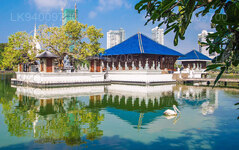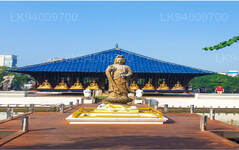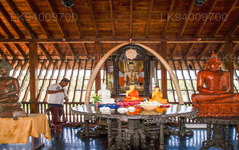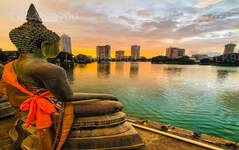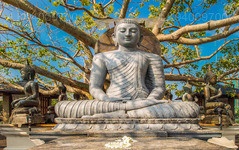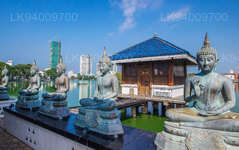
Città di Colombo
Colombo, la capitale dello Sri Lanka, è una città dinamica che fonde tradizione e modernità. Vanta un'architettura coloniale, vivaci mercati e sereni templi buddisti. Con una cucina variegata, uno skyline in continua crescita e splendide spiagge, è un vivace centro per gli affari, la cultura e il turismo, offrendo un punto di partenza ideale per esplorare le meraviglie dello Sri Lanka.
Seema Malaka
Within the heart of Colombo is the Gangarama Buddhist Temple. Built during the late 19th century for the Buddhists who lived in the capital city of Colombo; the temple sprawled over a large area of land and included several outer structures. The Seema Malaka is one of these. Originally, it was built with a foundation within the floor of Beira Lake, and was the image of stolidity. However, it was not able to withstand the marshy ground underneath the lake. By 1970 the Seema Malaka had sunk completely under the waters of Beira.
And then in 1976, Sir Geoffrey Bawa was hired to do this difficult construction design. He created three floating platforms interlinked by pontoon walkways and anchored to the base of the lake by way of stone pillars.
The light design ensured that the construction would not sink. The entire structure is connected to the shore using another pontoon bridge. He created a design that emulated the ancient monasteries of Anuradhapura and added his own signature modern twirl to it. Bawa was one of the most influential Asian architects of the mid to late 20th century and was well known for founding Tropical Modernism. This style is very apparent in the deep blue clay roof tiles of the main temple, the simplistic and yet delicate structure made of a collection of wooden spindles and banisters that lets plenty of air and light in, and the overall design that conforms to nature instead of fighting against it.Things to See
- The Central Platform: This platform has a number of Asian seated stone Buddhas along the perimeter of the platform. They are beautifully sculpted and come out well in photos. In the center is a room with slatted wooden walls. This comfortable place is used for meditation and yoga by visitors and devotees. It provides a relaxing view of the lake and its surroundings. It also has a beautiful large Buddha statue flanked by two giant elephant tusks. Before entering this room, you can take note of the Anuradhapura style dwarf guardian statues at the entrance; which are perfectly formed.
- The Northern Platform: This platform is sealed and is said to lead to the Treasury of the Truth. This houses a library of Buddhist texts and is only accessible by monks.
- The Courtyard: This is where the main part of Seema Malaka is. To one side of the courtyard, a comparatively small offshoot of the original sacred Bo tree in Anuradhapura grows out of a raised platform draped in prayer flags. It is flanked by Buddha statues of varied sizes – the biggest of which stands magnificently next to a small stupa. The courtyard has small rooms with wooden doors at the four corners. Within these are localized versions of Hindu Gods that the Buddhists worship as Devas. Just behind the main courtyard is a tier of stacked-up Buddha statues from Thailand. Close to this is the temple’s most surprising feature; a collection of vintage cars, presented by well-wishers over the years
- The Museum: On the way out of the entrance you can visit the museum. The temple museum has two big rooms overflowing with a treasure-trove of interesting objects; some collected for their symbolism, some for their artistic and/or financial value, and some just because. These include collections of ancient Sanskrit Ola leaf manuscripts, large sapphires and other precious stones, sandalwood and ivory carvings, brass statuettes of gods, jade & crystal monstrosities, elephant tusks, coins, innumerable Buddha images & statues of other Buddhist & Hindu deities, oil lamps, votive pagodas, old clocks, porcelain, ivory carvings, and even old gramophones. Overall they form what feels more like a cave of treasures that is definitely worth looking at.
Informazioni sul distretto di Colomb
Colombo è la città più grande e la capitale commerciale dello Sri Lanka. Si trova sulla costa occidentale dell'isola e adiacente a Sri Jayewardenepura Kotte, la capitale dello Sri Lanka. Colombo è una città vivace e trafficata, con un mix di vita moderna, edifici e rovine coloniali e una popolazione di 647.100 abitanti. La regione metropolitana di Colombo, definita dai distretti di Colombo, Gampaha e Kalutara, ha una popolazione stimata di 5.648.000 abitanti e si estende su una superficie di 3.694,20 km². Colombo è una città multietnica e multiculturale. È la città più popolosa dello Sri Lanka, con 642.163 abitanti che vivono entro i confini della città. La popolazione di Colombo è un mix di numerosi gruppi etnici, principalmente cingalesi, mori e tamil. In città vivono anche piccole comunità di persone di origine cinese, portoghese, olandese, malese e indiana, oltre a numerosi espatriati europei. La stragrande maggioranza delle aziende dello Sri Lanka ha sede a Colombo. Alcuni dei settori industriali includono prodotti chimici, tessili, vetro, cemento, pelletteria, arredamento e gioielleria. Nel centro città si trova il secondo edificio più alto dell'Asia meridionale: il World Trade Center.
Informazioni sulla provincia occidentale
La Provincia Occidentale è la provincia più densamente popolata dello Sri Lanka. Ospita la capitale legislativa Sri Jayawardenepura Kotte e Colombo, il centro amministrativo e commerciale della nazione. La Provincia Occidentale è divisa in 3 distretti principali: Colombo (642 km²), Gampaha (1.386,6 km²) e Kalutara (1.606 km²). Essendo il fulcro economico dello Sri Lanka, tutte le principali aziende locali e internazionali hanno sede in città, così come i principali negozi di stilisti e grandi magazzini, quindi preparatevi a concedervi un po' di shopping nella Provincia Occidentale. Avendo la popolazione più alta di tutte le province, quasi tutti i principali istituti scolastici dell'isola si trovano nella Provincia Occidentale. Le università della provincia includono l'Università di Colombo, l'Università di Sri Jayewardenepura, l'Università di Kelaniya, l'Università Aperta dello Sri Lanka, l'Università Buddista e Pali dello Sri Lanka, l'Università della Difesa Generale Sir John Kotelawala e l'Università di Moratuwa. La provincia occidentale ospita il maggior numero di scuole del paese, tra cui scuole nazionali, provinciali, private e internazionali.

